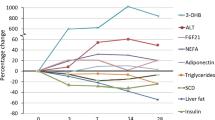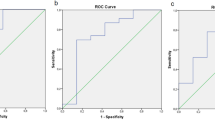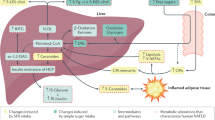Abstract
Background/Objectives:
Our objective was to investigate changes in liver fat and insulin sensitivity during a 2-year diet intervention. An ad libitum Paleolithic diet (PD) was compared with a conventional low-fat diet (LFD).
Subjects/Methods:
Seventy healthy, obese, postmenopausal women were randomized to either a PD or a conventional LFD. Diet intakes were ad libitum. Liver fat was measured with proton magnetic resonance spectroscopy. Insulin sensitivity was evaluated with oral glucose tolerance tests and calculated as homeostasis model assessment-insulin resistance (HOMA-IR)/liver insulin resistance (Liver IR) index for hepatic insulin sensitivity and oral glucose insulin sensitivity (OGIS)/Matsuda for peripheral insulin sensitivity. All measurements were performed at 0, 6 and 24 months. Forty-one women completed the examinations for liver fat and were included.
Results:
Liver fat decreased after 6 months by 64% (95% confidence interval: 54–74%) in the PD group and by 43% (27–59%) in the LFD group (P<0.01 for difference between groups). After 24 months, liver fat decreased 50% (25–75%) in the PD group and 49% (27–71%) in the LFD group. Weight reduction between baseline and 6 months was correlated to liver fat improvement in the LFD group (rs=0.66, P<0.01) but not in the PD group (rs=0.07, P=0.75). Hepatic insulin sensitivity improved during the first 6 months in the PD group (P<0.001 for Liver IR index and HOMA-IR), but deteriorated between 6 and 24 months without association with liver fat changes.
Conclusions:
A PD with ad libitum intake had a significant and persistent effect on liver fat and differed significantly from a conventional LFD at 6 months. This difference may be due to food quality, for example, a higher content of mono- and polyunsaturated fatty acids in the PD. Changes in liver fat did not associate with alterations in insulin sensitivity.
This is a preview of subscription content, access via your institution
Access options
Subscribe to this journal
Receive 12 print issues and online access
$259.00 per year
only $21.58 per issue
Buy this article
- Purchase on Springer Link
- Instant access to full article PDF
Prices may be subject to local taxes which are calculated during checkout



Similar content being viewed by others
References
Global Burden of Metabolic Risk Factors for Chronic Diseases Collaboration, Lu Y, Hajifathalian K, Ezzati M, Woodward M, Rimm EB et al. Metabolic mediators of the effects of body-mass index, overweight, and obesity on coronary heart disease and stroke: a pooled analysis of 97 prospective cohorts with 1.8 million participants. Lancet 2014; 383: 970–983.
Szczepaniak LS, Nurenberg P, Leonard D, Browning JD, Reingold JS, Grundy S et al. Magnetic resonance spectroscopy to measure hepatic triglyceride content: prevalence of hepatic steatosis in the general population. Am J Physiol Endocrinol Metab 2005; 288: E462–E468.
Ratziu V, Bellentani S, Cortez-Pinto H, Day C, Marchesini G . A position statement on NAFLD/NASH based on the EASL 2009 special conference. J Hepatol 2010; 53: 372–384.
Fabbrini E, Yoshino J, Yoshino M, Magkos F, Tiemann Luecking C, Samovski D et al. Metabolically normal obese people are protected from adverse effects following weight gain. J Clin Invest 2015; 125: 787–795.
Korenblat KM, Fabbrini E, Mohammed BS, Klein S . Liver, muscle, and adipose tissue insulin action is directly related to intrahepatic triglyceride content in obese subjects. Gastroenterology 2008; 134: 1369–1375.
Seppälä-Lindroos A, Vehkavaara S, Häkkinen AM, Goto T, Westerbacka J, Sovijärvi et al. Fat accumulation in the liver is associated with defects in insulin suppression of glucose production and serum free fatty acids independent of obesity in normal men. J Clin Endocrinol Metab 2002; 87: 3023–3028.
Thoma C, Day CP, Trenell MI . Lifestyle interventions for the treatment of non-alcoholic fatty liver disease in adults: a systematic review. J Hepatol 2012; 56: 255–266.
Haufe S, Haas V, Utz W, Birkenfeld AL, Jeran S, Bohnke J et al. Long-lasting improvements in liver fat and metabolism despite body weight regain after dietary weight loss. Diabetes Care 2013; 36: 3786–3792.
Jonsson T, Granfeldt Y, Ahren B, Branell UC, Palsson G, Hansson et al. Beneficial effects of a Paleolithic diet on cardiovascular risk factors in type 2 diabetes: a randomized cross-over pilot study. Cardiovasc Diabetol 2009; 8: 35.
Mellberg C, Sandberg S, Ryberg M, Eriksson M, Brage S, Larsson C et al. Long-term effects of a Palaeolithic-type diet in obese postmenopausal women: a 2-year randomized trial. Eur J Clin Nutr 2014; 68: 350–357.
Bozzetto L, Prinster A, Annuzzi G, Costagliola L, Mangione A, Vitelli et al. Liver fat is reduced by an isoenergetic MUFA diet in a controlled randomized study in type 2 diabetic patients. Diabetes Care 2012; 35: 1429–1435.
Ryan MC, Itsiopoulos C, Thodis T, Ward G, Trost N, Hofferberth S et al. The Mediterranean diet improves hepatic steatosis and insulin sensitivity in individuals with non-alcoholic fatty liver disease. J Hepatol 2013; 59: 138–143.
Lindeberg S, Jönsson T, Granfeldt Y, Borgstrand E, Soffman J, Sjöström K et al. A Palaeolithic diet improves glucose tolerance more than a Mediterranean-like diet in individuals with ischaemic heart disease. Diabetologia 2007; 50: 1795–1807.
Volzke H, Schwarz S, Baumeister SE, Wallaschofski H, Schwahn C, Grabe HJ et al. Menopausal status and hepatic steatosis in a general female population. Gut 2007; 56: 594–595.
Ryberg M, Sandberg S, Mellberg C, Stegle O, Lindahl B, Larsson C et al. A Palaeolithic-type diet causes strong tissue-specific effects on ectopic fat deposition in obese postmenopausal women. J Intern Med 2013; 274: 67–76.
Alexander J, Anderssen SA, Aro A, Becker W, Fogelholm M, Lyhne N et al. Nordic Nutrition Recommendations 2004, Integrating Nutrition and Physical Activity, 4th edn. Copenhagen: Norden, 2004.
Stegle O, Fallert SV, MacKay DJ, Brage S . Gaussian process robust regression for noisy heart rate data. IEEE Trans Biomed Eng 2008; 55: 2143–2151.
Brage S, Westgate K, Wijndaele K, Godinho J, Griffin S, Wareham N . Evaluation Of A Method For Minimizing Diurnal Information Bias In Objective Sensor Data. 3rd International Conference on Ambulatory Monitoring of Physical Activity and Movement; June 17-19, 2013; Amherst, MA, USA, 2013.
Brage S, Ekelund U, Brage N, Hennings MA, Froberg K, Franks PW et al. Hierarchy of individual calibration levels for heart rate and accelerometry to measure physical activity. J Appl Physiol (1985) 2007; 103: 682–692.
Bolinder J, Ljunggren O, Kullberg J, Johansson L, Wilding J, Langkilde AM et al. Effects of dapagliflozin on body weight, total fat mass, and regional adipose tissue distribution in patients with type 2 diabetes mellitus with inadequate glycemic control on metformin. J Clin Endocrinol Metab 2012; 97: 1020–1031.
Kullberg J, Ahlstrom H, Johansson L, Frimmel H . Automated and reproducible segmentation of visceral and subcutaneous adipose tissue from abdominal MRI. Int J Obes (Lond) 2007; 31: 1806–1817.
Vangipurapu J, Stancakova A, Kuulasmaa T, Paananen J, Kuusisto J, Ferrannini E et al. A novel surrogate index for hepatic insulin resistance. Diabetologia 2011; 54: 540–543.
Matthews DR, Hosker JP, Rudenski AS, Naylor BA, Treacher DF, Turner RC . Homeostasis model assessment: insulin resistance and beta-cell function from fasting plasma glucose and insulin concentrations in man. Diabetologia 1985; 28: 412–419.
Mari A, Pacini G, Murphy E, Ludvik B, Nolan JJ . A model-based method for assessing insulin sensitivity from the oral glucose tolerance test. Diabetes Care 2001; 24: 539–548.
Matsuda M, DeFronzo RA . Insulin sensitivity indices obtained from oral glucose tolerance testing: comparison with the euglycemic insulin clamp. Diabetes Care 1999; 22: 1462–1470.
Otten J, Ahren B, Olsson T . Surrogate measures of insulin sensitivity vs the hyperinsulinaemic-euglycaemic clamp: a meta-analysis. Diabetologia 2014; 57: 1781–1788.
Westerbacka J, Lammi K, Hakkinen AM, Rissanen A, Salminen I, Aro et al. Dietary fat content modifies liver fat in overweight nondiabetic subjects. J Clin Endocrinol Metab 2005; 90: 2804–2809.
Parker HM, Johnson NA, Burdon CA, Cohn JS, O'Connor HT, George J . Omega-3 supplementation and non-alcoholic fatty liver disease: a systematic review and meta-analysis. J Hepatol 2012; 56: 944–951.
Rosqvist F, Iggman D, Kullberg J, Cedernaes J, Johansson HE, Larsson et al. Overfeeding polyunsaturated and saturated fat causes distinct effects on liver and visceral fat accumulation in humans. Diabetes 2014; 63: 2356–2368.
Neuschwander-Tetri BA . Hepatic lipotoxicity and the pathogenesis of nonalcoholic steatohepatitis: the central role of nontriglyceride fatty acid metabolites. Hepatology 2010; 52: 774–788.
Gastaldelli A, Cusi K, Pettiti M, Hardies J, Miyazaki Y, Berria R et al. Relationship between hepatic/visceral fat and hepatic insulin resistance in nondiabetic and type 2 diabetic subjects. Gastroenterology 2007; 133: 496–506.
Bugianesi E, Gastaldelli A, Vanni E, Gambino R, Cassader M, Baldi S et al. Insulin resistance in non-diabetic patients with non-alcoholic fatty liver disease: sites and mechanisms. Diabetologia 2005; 48: 634–642.
Perry RJ, Samuel VT, Petersen KF, Shulman GI . The role of hepatic lipids in hepatic insulin resistance and type 2 diabetes. Nature 2014; 510: 84–91.
Bojsen-Moller KN, Dirksen C, Jorgensen NB, Jacobsen SH, Serup AK, Albers PH et al. Early enhancements of hepatic and later of peripheral insulin sensitivity combined with increased postprandial insulin secretion contribute to improved glycemic control after Roux-en-Y gastric bypass. Diabetes 2014; 63: 1725–1737.
Lim EL, Hollingsworth KG, Aribisala BS, Chen MJ, Mathers JC, Taylor R . Reversal of type 2 diabetes: normalisation of beta cell function in association with decreased pancreas and liver triacylglycerol. Diabetologia 2011; 54: 2506–2514.
Haufe S, Engeli S, Kast P, Bohnke J, Utz W, Haas V et al. Randomized comparison of reduced fat and reduced carbohydrate hypocaloric diets on intrahepatic fat in overweight and obese human subjects. Hepatology 2011; 53: 1504–1514.
Shulman GI . Ectopic fat in insulin resistance, dyslipidemia, and cardiometabolic disease. N Engl J Med 2014; 371: 1131–1141.
Cnop M, Landchild MJ, Vidal J, Havel PJ, Knowles NG, Carr DR et al. The concurrent accumulation of intra-abdominal and subcutaneous fat explains the association between insulin resistance and plasma leptin concentrations: distinct metabolic effects of two fat compartments. Diabetes 2002; 51: 1005–1015.
Ross R, Aru J, Freeman J, Hudson R, Janssen I . Abdominal adiposity and insulin resistance in obese men. Am J Physiol Endocrinol Metab 2002; 282: E657–E663.
Koda M, Kawakami M, Murawaki Y, Senda M . The impact of visceral fat in nonalcoholic fatty liver disease: cross-sectional and longitudinal studies. J Gastroenterol 2007; 42: 897–903.
Acknowledgements
We thank the women who participated in this study and research nurses Inger Arnesjö and Katarina Iselid for their invaluable contributions. We would like to thank Marie Eriksson of the Department of Statistics, Umeå University, Sweden, for advice on statistics, and Elin Chorell of the Department of Public Health and Clinical Medicine, Umeå University, for analyzing beta-hydroxybutyrate. This study was supported by grants from The Swedish Council for Working Life and Social Research (2006-0699 and 2010-0398), the Swedish Research Council (K2011-12237-15-6), the Swedish Heart and Lung Foundation, King Gustaf V and Queen Victoria’s Foundation, the Swedish Diabetes Research Foundation, the County Council of Västerbotten and Umeå University, Sweden.
Author contributions
JO performed the statistical analysis, interpreted the data, drafted the figure and tables and wrote the manuscript. CM recruited participants, collected the data, performed the statistical analysis and wrote the manuscript. MR recruited participants, collected the data and edited the manuscript. SS recruited participants and collected the data. JK analyzed the VAT and SAT data. CL and BL designed the study and interpreted the data. JH analyzed the liver spectroscopy data. TO designed the study, recruited participants, collected the data, interpreted the data and wrote the manuscript. All authors actively participated in revising the paper and gave approval of the final version. JO is the guarantor of this work and, as such, had full access to all the data in the study and takes responsibility for the integrity of the data and the accuracy of the data analysis.
Author information
Authors and Affiliations
Corresponding author
Ethics declarations
Competing interests
The authors declare no conflict of interest.
Rights and permissions
About this article
Cite this article
Otten, J., Mellberg, C., Ryberg, M. et al. Strong and persistent effect on liver fat with a Paleolithic diet during a two-year intervention. Int J Obes 40, 747–753 (2016). https://doi.org/10.1038/ijo.2016.4
Received:
Revised:
Accepted:
Published:
Issue Date:
DOI: https://doi.org/10.1038/ijo.2016.4
This article is cited by
-
Lifestyle interventions in nonalcoholic fatty liver disease
Nature Reviews Gastroenterology & Hepatology (2023)
-
The healthy Nordic diet for blood glucose control: a systematic review and meta-analysis of randomized controlled clinical trials
Acta Diabetologica (2020)
-
Effects of a healthy Nordic diet on weight loss in adults: a systematic review and meta-analysis of randomized controlled clinical trials
Eating and Weight Disorders - Studies on Anorexia, Bulimia and Obesity (2020)
-
Influence of Paleolithic diet on anthropometric markers in chronic diseases: systematic review and meta-analysis
Nutrition Journal (2019)
-
A heterogeneous response of liver and skeletal muscle fat to the combination of a Paleolithic diet and exercise in obese individuals with type 2 diabetes: a randomised controlled trial
Diabetologia (2018)



